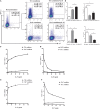Cigarette Smoke Induction of Interleukin-27/WSX-1 Regulates the Differentiation of Th1 and Th17 Cells in a Smoking Mouse Model of Emphysema
- PMID: 27994590
- PMCID: PMC5136545
- DOI: 10.3389/fimmu.2016.00553
Cigarette Smoke Induction of Interleukin-27/WSX-1 Regulates the Differentiation of Th1 and Th17 Cells in a Smoking Mouse Model of Emphysema
Abstract
IFN-γ-producing CD4+ T (Th1) cells and IL-17-producing CD4+ T (Th17) cells play a critical role in the pathogenesis of chronic obstructive pulmonary disease (COPD). However, the immune regulation between Th1 and Th17 cells remains unclear. Previous studies have demonstrated that interleukin-27 (IL-27)/WSX-1 exerted pro- or anti-inflammatory effects in many acute inflammatory diseases by modulating T cell-mediated immune response, but little was known about its role in chronic inflammatory disease, especially in smoking-related lung diseases. Considering IL-27 is an important regulator in T lymphocytes immune responses and was found markedly increased in patients with COPD, we hypothesized that IL-27/WSX-1 may exert immuno-regulatory effects on the differentiation of Th1 and Th17 cells in smoking-related COPD. In this study, we aimed to evaluate the expression of IL-27 in patients with COPD and explore the role of IL-27/WSX-1 on Th1 and Th17 cells differentiation in a smoking mouse model of emphysema. We found that elevated expression of IL-27 was associated with increased proportion of Th1 cells and Th17 cells in patients with COPD and demonstrated parallel findings in cigarette smoke-exposed mice. In addition, cigarette smoke exposure upregulated the expression of IL-27R (WSX-1) by naive CD4+ T cells in mice. In vitro, IL-27 significantly augmented the secretion of IFN-γ by naive CD4+ T cells via a T-bet, p-STAT1, and p-STAT3-dependent manner, but inhibited the production of IL-17 by a ROR-γt and p-STAT1-dependent way. Furthermore, anti-IL27 treatment dramatically decreased the expression of IFN-γ-producing CD4+ T cells in cigarette smoke-exposed mice. These findings proposed that IL-27 has functions for promoting the expression of Th1 cells but inhibiting the expression of Th17 cells in vitro and IL-27 neutralization-attenuated Th1-mediated inflammation in vivo, suggesting targeting IL-27/WSX-1 may provide a new therapeutic approach for smoking-related COPD.
Keywords: COPD; IL-27/WSX-1; Th1 cells; Th17 cells; cigarette smoke exposure.
Figures











Similar articles
-
Infiltration of IL-17-Producing T Cells and Treg Cells in a Mouse Model of Smoke-Induced Emphysema.Inflammation. 2016 Aug;39(4):1334-44. doi: 10.1007/s10753-016-0365-8. Inflammation. 2016. PMID: 27150336
-
[Effect of interleukin-17-producing CD4+ T helper lymphocytes on cigarette smoke-induced lung inflammation and emphysema in mice].Zhonghua Jie He He Hu Xi Za Zhi. 2011 Apr;34(4):259-64. Zhonghua Jie He He Hu Xi Za Zhi. 2011. PMID: 21609608 Chinese.
-
Cigarette smoke alters the ability of human dendritic cells to promote anti-Streptococcus pneumoniae Th17 response.Respir Res. 2016 Jul 26;17(1):94. doi: 10.1186/s12931-016-0408-6. Respir Res. 2016. PMID: 27460220 Free PMC article.
-
Green tea EGCG, T cells, and T cell-mediated autoimmune diseases.Mol Aspects Med. 2012 Feb;33(1):107-18. doi: 10.1016/j.mam.2011.10.001. Epub 2011 Oct 14. Mol Aspects Med. 2012. PMID: 22020144 Review.
-
Regulatory B and T cell responses in patients with autoimmune thyroid disease and healthy controls.Dan Med J. 2016 Feb;63(2):B5177. Dan Med J. 2016. PMID: 26836805 Review.
Cited by
-
IL-27 Rα+ cells promoted allorejection via enhancing STAT1/3/5 phosphorylation.J Cell Mol Med. 2020 Sep;24(18):10756-10767. doi: 10.1111/jcmm.15700. Epub 2020 Aug 6. J Cell Mol Med. 2020. PMID: 32761753 Free PMC article.
-
Histone Deacetylase 2 Suppresses Skeletal Muscle Atrophy and Senescence via NF-κB Signaling Pathway in Cigarette Smoke-Induced Mice with Emphysema.Int J Chron Obstruct Pulmon Dis. 2021 Jun 4;16:1661-1675. doi: 10.2147/COPD.S314640. eCollection 2021. Int J Chron Obstruct Pulmon Dis. 2021. PMID: 34113097 Free PMC article.
-
Th17 profile in COPD exacerbations.Int J Chron Obstruct Pulmon Dis. 2017 Jun 22;12:1857-1865. doi: 10.2147/COPD.S136592. eCollection 2017. Int J Chron Obstruct Pulmon Dis. 2017. PMID: 28694696 Free PMC article. Review.
-
Enhanced lung inflammatory response in whole-body compared to nose-only cigarette smoke-exposed mice.Respir Res. 2021 Mar 17;22(1):86. doi: 10.1186/s12931-021-01680-5. Respir Res. 2021. PMID: 33731130 Free PMC article.
-
Rapamycin attenuates Tc1 and Tc17 cell responses in cigarette smoke-induced emphysema in mice.Inflamm Res. 2019 Nov;68(11):957-968. doi: 10.1007/s00011-019-01278-0. Epub 2019 Aug 29. Inflamm Res. 2019. PMID: 31468083
References
LinkOut - more resources
Full Text Sources
Other Literature Sources
Research Materials
Miscellaneous

